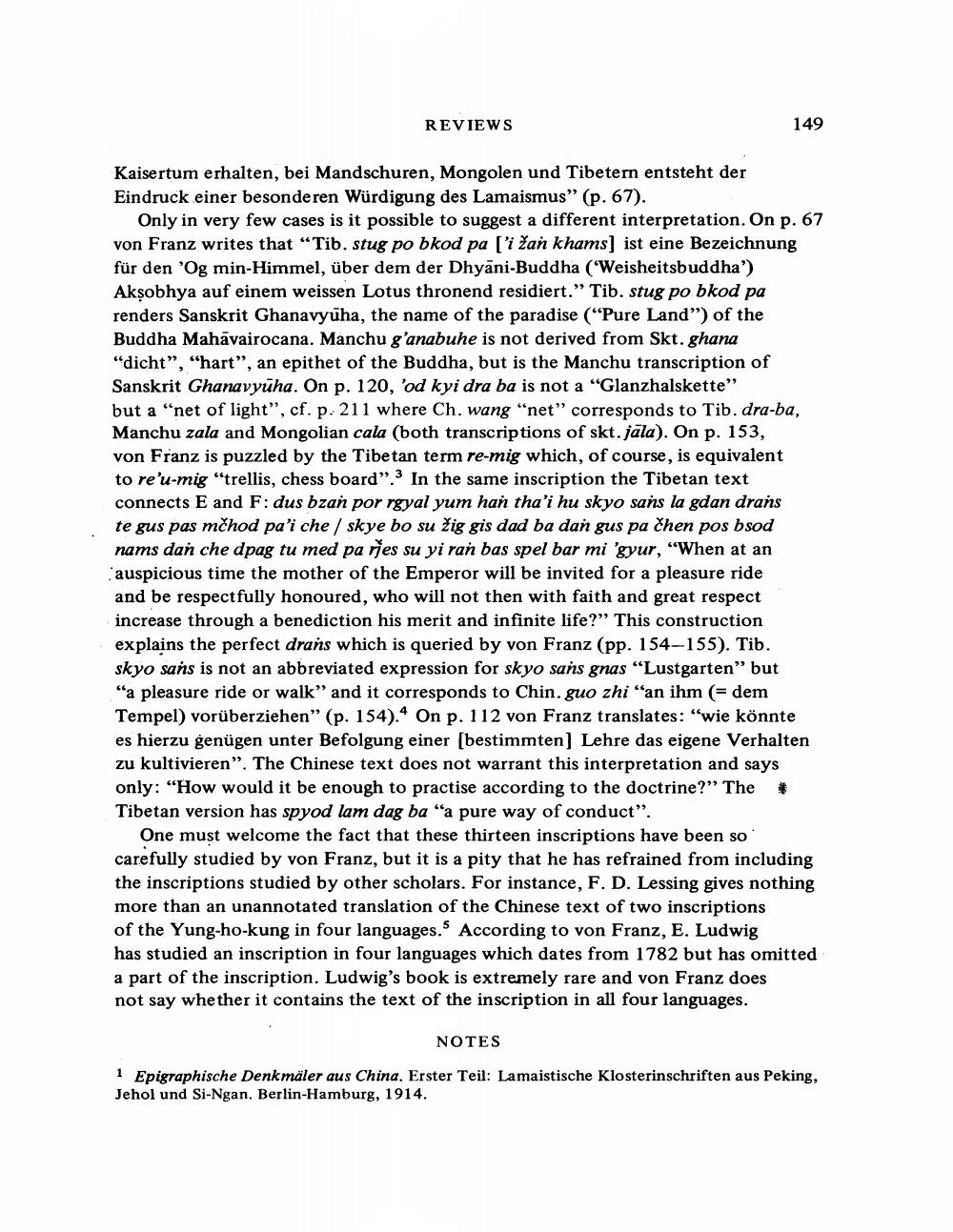Book Title: Reviews Of Diffeent Books Author(s): Publisher: View full book textPage 3
________________ REVIEWS 149 Kaisertum erhalten, bei Mandschuren, Mongolen und Tibetern entsteht der Eindruck einer besonderen Wurdigung des Lamaismus" (p. 67). Only in very few cases is it possible to suggest a different interpretation. On p. 67 von Franz writes that "Tib. stug po bkod pa ['i zan khams) ist eine Bezeichnung fur den 'Og min-Himmel, uber dem der Dhyani-Buddha ('Weisheitsbuddha') Aksobhya auf einem weissen Lotus thronend residiert." Tib. stug po bkod pa renders Sanskrit Ghanavyuha, the name of the paradise ("Pure Land") of the Buddha Mahavairocana. Manchu g'anabuhe is not derived from Skt. ghana "dicht", "hart", an epithet of the Buddha, but is the Manchu transcription of Sanskrit Ghanavyuha. On p. 120, 'od kyi dra ba is not a "Glanzhalskette" but a "net of light", cf. p. 211 where Ch. wang "net" corresponds to Tib. dra-ba, Manchu zala and Mongolian cala (both transcriptions of skt. jala). On p. 153, von Franz is puzzled by the Tibetan term re-mig which, of course, is equivalent to re'u-mig "trellis, chess board". In the same inscription the Tibetan text connects E and F: dus bzan por rgyal yum han tha'i hu skyo sans la gdan drans te gus pas mchod pa'i che / skye bo su Zig gis dad ba dan gus pa chen pos bsod nams dan che dpag tu med pa rjes su yi ran bas spel bar mi 'gyur, "When at an auspicious time the mother of the Emperor will be invited for a pleasure ride and be respectfully honoured, who will not then with faith and great respect increase through a benediction his merit and infinite life?" This construction explains the perfect drans which is queried by von Franz (pp. 154-155). Tib. skyo sans is not an abbreviated expression for skyo sans gnas "Lustgarten" but "a pleasure ride or walk" and it corresponds to Chin. guo zhi "an ihm (= dem Tempel) voruberziehen" (p. 154).4 On p. 112 von Franz translates: "wie konnte es hierzu genugen unter Befolgung einer [bestimmten] Lehre das eigene Verhalten zu kultivieren". The Chinese text does not warrant this interpretation and says only: "How would it be enough to practise according to the doctrine?" The # Tibetan version has spyod lam dag ba "a pure way of conduct". One must welcome the fact that these thirteen inscriptions have been so carefully studied by von Franz, but it is a pity that he has refrained from including the inscriptions studied by other scholars. For instance, F. D. Lessing gives nothing more than an unannotated translation of the Chinese text of two inscriptions of the Yung-ho-kung in four languages. According to von Franz, E. Ludwig has studied an inscription in four languages which dates from 1782 but has omitted a part of the inscription. Ludwig's book is extremely rare and von Franz does not say whether it contains the text of the inscription in all four languages. NOTES 1 Epigraphische Denkmaler aus China. Erster Teil: Lamaistische Klosterinschriften aus Peking, Jehol und Si-Ngan. Berlin-Hamburg, 1914.Page Navigation
1 2 3 4 5 6 7 8
